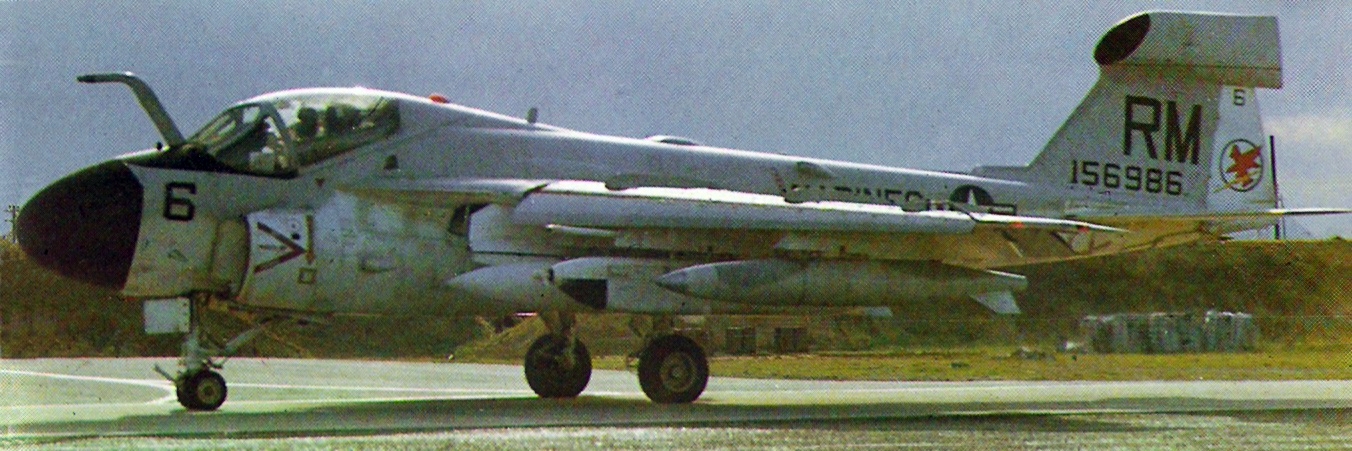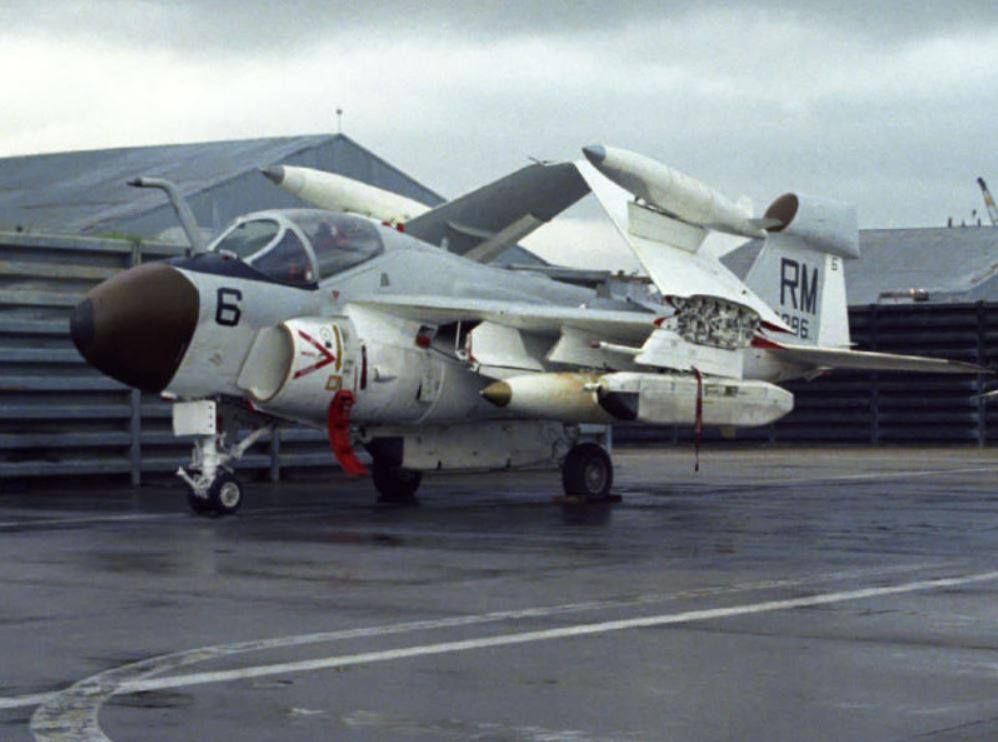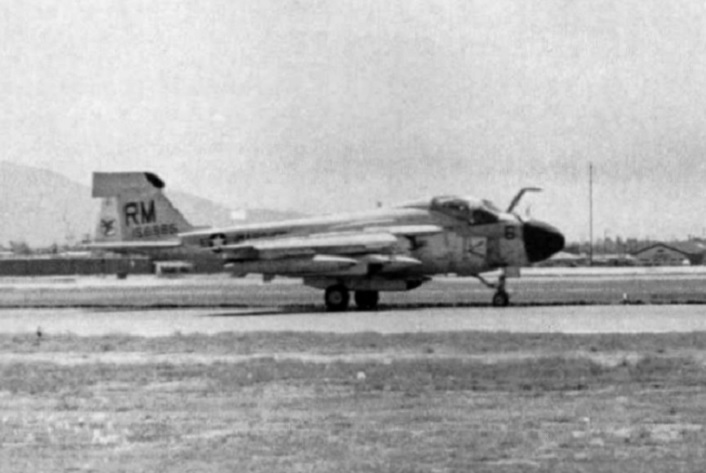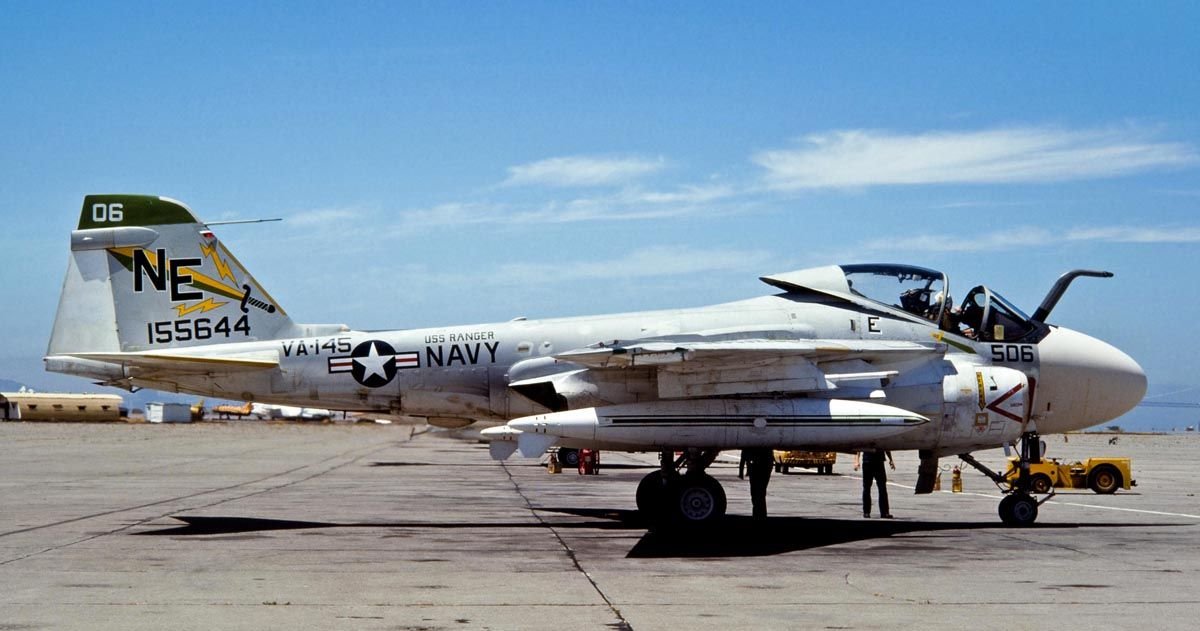Ijzeren dikkoppen
De Grumman A-6 Intruder werd in 1963 in de Navy in dienst genomen, en in 1997 met pensioen gestuurd.
Er werden 693 stuks gebouwd in diverse varianten: A-6A, A-6B, A-6C, A-6E en A-6E TRAM, allemaal toestellen bedoeld voor het aanvallen van gronddoelen. Ook was er de KA-6D, een vliegende brandstofpomp. Voor elektronische oorlogsvoering werd een aantal EA-6A toestellen gebouwd. Alle genoemde types zijn tweezitters. Uit de EA-6A werd de EA-6B Prowler ontwikkeld, een vierzitter, eveneens voor elektronische oorlogsvoering. De EA-6A en B zijn heel goed herkenbaar aan de stoorgondel bovenop het verticaal staartvlak. Omwille van de typische rompvorm kreeg de Intruder al gauw de bijnaam Ijzeren Dikkop. |
Iron tadpoles
The Grumman A-6 Intruder went into Navy service in 1963 and was retired in 1997.
693 copies were built in different variants: A-6A, A-6B, A-6C, A-6E and A-6E TRAM, all of which were tasked with the ground attack role. There was also the KA-6D, a flying gas station. A number of EA-6A variants were produced for the electronic warfare missions. All of the aforementioned types are two-seaters. The EA-6B Prowler, a four-seater, was developed from the EA-6A, and also used in electronic warfare. Both the EA-6A and B are easily recognisable by the large jamming pod atop their vertical tail. Because of the typical shape of the fuselage, the Intruder soon acquired the nickname Iron Tadpole. |
Bouwverslag
Ik gebruikte voor dit project drie Revell kits: een A-6E (kit 5626) die ik als een A-6A bouwde, een A-6E (kit 04578) en een EA-6A (kit 4570), allemaal al lang uit productie.
De oudste van die kits kocht ik in 1986, een andere in 1992, en bij de derde stond geen datum op de doos... Hoog tijd dat die kits hun weg van de zolder naar de werkbank vonden! De kits zijn alle drie in dezelfde typische Revell-kwaliteit van die tijd: opliggende paneellijnen, veel ejector pin marks, en de pasvorm is ook niet erg bijzonder. Positief is dan weer de erg volledige bewapening. Wel nodig bij een grondaanvalsvliegtuig. In de loop der jaren verzamelde ik een aantal decal sets voor de A-6, waarvan ik er geen enkele gebruikt heb bij dit project... Voor de EA-6A gebruikte ik de kit decals voor de generieke zaken zoals nationaliteitskentekens, waarschuwingen en stencils. De kwaliteit ervan was niet erg denderend. Niet helemaal in register, en erg dik. Voor de eenheidskentekens scande ik het squadron insigne in dat ik vond in een boek over de Intruder, en de lettering voor MARINES, VMCJ-1 en de serienummers tekende ik in AutoCAD. Ook die scan heb ik opnieuw getekend en ingekleurd. Al die huisvlijt werd vervolgens tweemaal op decalfilm geprint. Alle drie kregen ze een neus vol loodhagel om te beletten dat ze op hun staart kwamen te zitten. |
Building the kits
For this project I used three Revell kits: an A-6E (kit 5626) which I built as an A-6A, an A-6E (kit 04578) and an EA-6A (kit 4570), all long since out of production.
The oldest of the three I bought way back in 1986, another in 1992 but for the third one I unfortunately forgot to date the box, so I can't give an exact year... High time these kits found their way from the attic to the workbench! The kits are all of the same quality typical of Revell in that era: raised panel lines, lots of ejector pin marks, and the fit isn't all that good. On the plus side there is the copious and varied ordnance; a must for a ground attack aircraft. Over the years I picked up a number of decal sheets for the A-6, none of which I used in this project... For the EA-6A I used the kit decals for the generic markings, such as national insigna, stencils and warnings. The quality of the kit decals was on the poor side: not quite in register and very thick. I made the unit markings myself from a scan I made from one of my books. The scan was loaded into AutoCAD, drawn over with linework and solid hatches. Lettering for MARINES, VMCJ-1 and the serials were also drawn in AutoCAD. All this artwork was subsequently printed on clear decal film. All three aircraft received a nose full of lead shot to keep them from becoming tail sitters. |
 |
|
|
Deze EA-6A was toegewezen aan VMCJ-1 Golden Hawks, een Marines eenheid die in de jaren 1968-69 te Da Nang, Zuid-Vietnam gestationeerd was.
Onder de vleugels van het model hangen vier ALQ-76 ECM gondels, een AGM-45 Shrike anti-radiation missile en een AN/ALE-41 chaff dispenser pod. Onder de romp ook een brandstoftank. |
This EA-6A was assigned to VMCJ-1 Golden Hawks, a Marines unit which, during 1968-69, was stationed at Da Nang, South-Vietnam.
Below the model's wings are four ALQ-76 ECM pods, a single AGM-45 Shrike anti-radiation missile and an AN/ALE-41 chaff dispenser pod. There is also a fuel tank slung under the fuselage. |
 |
|
 |
|
|
Achter de straalpijpen bevinden zich op de romp een stel luchtremmen. Die voldeden niet helemaal, en bij latere modellen werden deze achterwege gelaten.
Nieuwe toestellen kregen luchtremmen aan de vleugeltips. Bij een groot onderhoud werden oudere toestellen van de nieuwe luchtremmen voorzien, en de oude werden afgedekt of vastgezet.
Maar in 1967, het jaar waarin deze Intruder geportretteerd is, was dat nog niet aan de orde...
|
Aft of the jet exhausts, the fuselage sports a set of air brakes. They were not really up to their task and were omitted on later models.
Newer airframes saw the airbrakes moved to the wing tips. When undergoing depot maintenance the older airframes were retrofitted with the new air brakes and the old ones were either faired over or bolted shut.
But in 1967, the year in which this Intruder is portrayed, all of that was yet to come... |
|
De A-6A in de kleuren van VA-145 Swordsmen is nogal bijzonder.
Deze eenheid was de eerste en enige Navy A-6 eenheid die lasergeleide bommen gebruikte om in Noord-Vietnam moeilijke doelwitten zoals spoorwegbruggen te bombarderen. Men probeerde reeds jaren deze bruggen met conventionele bommen neer te halen, en af en toe viel er eens een bom op de brug. Doch doorgaans schoot de NVA (North Vietnamese Army) vaker een aanvalsvliegtuig neer dan dat de Navy of Air Force een brug raakte. Daar kwam verandering in toen op 15 januari 1973 VA-145 vanaf de USS Ranger hun eerste aanval met de Pave Knife lasergondel (dat groot krom ding onder de romp) en twee lasergeleide 2000-pond bommen van het type LGB-10 Paveway onder de vleugels vloog. Zo goed als elke bom was raak, en de piloten moesten de dag erna niet meer terugkomen om de klus af te maken. De decals zijn van Furball Aero Design, zo goed als uitverkocht, maar ik vond nog een set bij The 48ers. Heel sympathieke kerels daar: ik vergat domweg mijn huisnummer op het bestelformulier, en via track&trace zag ik de decals vanuit Cyprus naar Gent vertrekken – en wegens onbestelbaar ook naar Cyprus terugkeren. Ik contacteerde hen, en biechtte mijn miskleun op. Geen probleem, ze hebben die decals op hun kosten opnieuw verzonden. Alle lof! Van 505 kon ik geen afbeeldingen vinden, maar dit is 506 in dezelfde periode: |
The A-6A in the markings of VA-145 Swordsmen is somewhat special.
They were the first and only A-6 unit to employ laser-guided bombs over North Vietnam in order to hit difficult targets such as railway bridges. For years both Navy and Air Force tried to bring down these bridges using conventional bombs, and once in a while they scored a hit. However, the number of yankee aircraft shot down by the NVA was higher than the amount of bombs that hit a bridge. All that was soon to change when on January 15th 1973 VA-145 aircraft took off from USS Ranger carrying a Pave Knife laser designator pod on the centreline (the big bent thing) and a pair of laser-guided 2000 lbs LGB-10 Paveway bombs underwing. Almost every bomb scored a direct hit, and the pilots didn't need to come back the next day to finish the job. The decals are from Furball Aero Design and are as good as sold out, but I managed to source a set from The 48ers. The guys there really are very good eggs. I stupidly forgot to put my housenumber on the order form and so it happened that I could track & trace the decals going from Cyprus to Ghent - and because they were undeliverable - saw them go back all the way to Cyprus. I contacted them and confessed to my cock-up. No problem, they mailed the decals once more, and at their own expense. Very commendable! 505 wasn't to be found on the internet, but here's 506 during the same time frame: |
 |
|
|
Voor de A-6E in de versie van de Navy eenheid VA-196 Main Battery gebruikte ik de kit decals, die ditmaal van prima kwaliteit waren.
We zien de kleurrijke CAG bird aan boord van de Coral Sea tijdens haar laatste WestPac cruise van 1981-82 in de Zuid-Chinese Zee. Tot de tanden gewapend met 12 Mk82 Snakeye 500-ponds bommen, en 8 CBU-78 Gator cluster bommen in het kader van de NATO-oefening Display Determination. Onder de romp hangt nog een brandstoftank. Niet veel later werden ook deze vroege E-modellen volledig in het grijs gespoten. Gedaan met felgekleurde Navy jets. Van dit toestel in deze specifieke beschildering vond ik evenmin een goede foto... |
For the A-6E in the markings of Navy unit VA-196 Main Battery I used the kit decals, which in this instance were top notch.
We see the colourful CAG bird aboard USS Coral Sea during her last WestPac cruise in 1981-82 in the South China Sea, armed to the teeth with 12 Mk82 Snakeye 500 lbs bombs, and 8 CBU-78 Gator cluster bombs for NATO excercise Display Determination. There's also a fuel tank on the centreline. Not much later these early E-models were sprayed in an overall grey scheme. Gone were the years of brightly coloured navy jets. This particular aircraft proved to be elusive when it came to finding a picture... |
|
Gegevens: Lengte: 16.7 m Hoogte: 4.9 m Spanwijdte: 16.1 m Max. startgewicht: 27.300 kg Max. snelheid: 1.037 km/h Actieradius: 1626 km Plafond: 13.000 m |
Data: Length: 16.7 m Height: 4.9 m Span: 16.1 m Max. take-off weight: 27.300 kg Max. speed: 1.037 km/h Range: 1626 km Ceiling: 13.000 m |